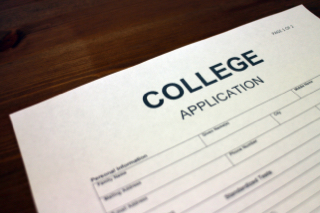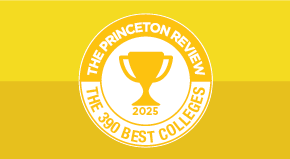Though it may seem easy to figure out when to apply to college, it's actually pretty complicated. The first things to consider are: What are the policies that my dream schools have? and Which option for each school makes the most sense for me?

College Application Deadlines: Options, Options, and More Options!
Different schools have different options (and deadlines!) for applying. Research is a key part of the entire college application process—The Princeton Review has information about 1,440 schools.
For those looking seeking flexibility, see which of these admissions options are offered at the colleges you're applying to:
-
Regular Decision
-
Rolling Admission
-
Early Decision
-
Early Action
Each of these options have similarities across different colleges; however, it’s vital to research the specific dates and requirements of each school when making your application plan.
Regular Decision
Regular Decision is the default application process for the majority of schools and is the most common way students apply. There are no restrictions or confusing policies to follow when applying Regular Decision and deadlines are usually around January 1. However, be sure to check the exact date for each school you are applying to and stay organized when planning your application schedule. Some schools have earlier deadlines, like the University of California system, which usually has a November 30 deadline. With regular decision, your application needs to be in before the deadline (test scores can sometimes come in after the deadline, but it’s best to have your scores before you apply, and it’s imperative that you check the school's requirements). The school will review applications and send out decisions well before the May 1 national college decision day, usually starting in early February.
Rolling Admissions
Rolling Admission, like Regular Decision, does not impose restrictions on how many schools you can apply to. Unlike Regular Decision, however, the college starts sending out acceptance letters as they start getting applications, often responding to students in the order in which their applications were received. (Some schools have internal mini-deadlines, for instance, batching and responding to all the applications received by a certain date before moving to the next group.)
If you’re considering schools with Rolling Admissions, we at The Princeton Review recommend that you apply as early as possible.
-
Earlier in the admissions window, there are more spots available in the incoming class, increasing the likelihood that you’ll be accepted.
-
At many schools, an earlier acceptance will give you priority with housing, financial aid, and other elements of your college experience.
-
Because Rolling Admissions windows can start as early as August the year before you start college, it’s very important to do your research and put together your application in time to apply.
Early Decision
Early Decision is a process in which you apply early (usually November 1) and receive an early response from the school early (usually by December). That means you can know where you’re going to college before winter break of your senior year. And, even if you’re not accepted Early Decision, you’ll still be deferred to the Regular Decision process, meaning still be accepted. Pretty sweet, right?
Three caveats:
-
You can apply Early Decision to only one school. This is because:
-
If you’re accepted to a school via Early Decision, you must attend that school and withdraw your other applications.
-
You must accept or decline the offer well before the May 1 national decision deadline.
These restrictions have led to a number of criticisms of Early Decision around financial aid. While Early Decision does say that the financial aid offered by the school must be “considered adequate by the family,” there is still risk that disproportionately affects students from lower income families.
Now, if there is a school that is absolutely your number 1, I-will-attend-if-accepted school, it makes a lot of sense to apply Early Decision. Doing so demonstrates your commitment to a school, and as discussed above, can solidify your college plans early. At some schools, applying Early Decision can increase your chances of acceptance, but this advantage is far from universal. Spend a lot of time discussing the pros and cons with your parents or guardians, school counsellors, and admissions officers at your goal school before going the Early Decision route.
Early Action
If Early Decision sounds like too much commitment for you, many schools also offer Early Action.
-
Early Action often has the same November 1 deadline as Early Decision, but if you’re accepted, you’re not bound to attend a school.
-
You’ll get a decision sooner than students applying under Regular Decision (usually in January), but not as soon as those applying Early Decision.
-
Some schools have additional Early Action deadlines (commonly November 15 or December 1) in case you miss the first November 1 deadline.
-
Your deadline for accepting an offer is the same as if you applied under Regular Decision or Rolling Admissions: May 1.
Early Action sounds ideal, though be aware of limitations from schools (like Harvard College) where you can only apply to that school Early Action. The primary differences from Early Decision are that you are not bound to attend such a school if you are admitted, and you are free to apply to other schools under their Regular Decision or Rolling Admissions processes.
Be Organized!
There are a lot of factors to keep in mind when deciding what process to use to apply to which school. We at The Princeton Review recommend starting early to give yourself the best opportunity to shine in your applications. We also offer many free webinars, books, and admissions counsellors to help you be successful in the college admissions process.
Explore Colleges For You
Connect with our featured colleges to find schools that both match your interests and are looking for students like you.
Get Started on Athletic Scholarships & Recruiting!
Join athletes who were discovered, recruited & often received scholarships after connecting with NCSA's 42,000 strong network of coaches.
Best 390 Colleges
168,000 students rate everything from their professors to their campus social scene.
Explore Colleges For You
Connect with our featured colleges to find schools that both match your interests and are looking for students like you.
Get Started on Athletic Scholarships & Recruiting!
Join athletes who were discovered, recruited & often received scholarships after connecting with NCSA's 42,000 strong network of coaches.
Best 390 Colleges
168,000 students rate everything from their professors to their campus social scene.
Explore Colleges For You
Connect with our featured colleges to find schools that both match your interests and are looking for students like you.
Get Started on Athletic Scholarships & Recruiting!
Join athletes who were discovered, recruited & often received scholarships after connecting with NCSA's 42,000 strong network of coaches.
Best 390 Colleges
168,000 students rate everything from their professors to their campus social scene.



